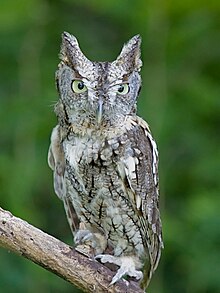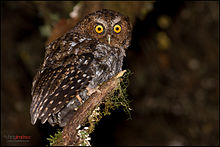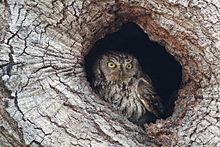Screech owl
Parts of this article (those related to screech owl evolution, taxonomy, and systematics) need to be updated. (September 2019) |
| Screech owl Temporal range: Miocene to present
| |
|---|---|

| |
morph
| |

| |
| Gray morph | |
| Scientific classification | |
| Domain: | Eukaryota |
| Kingdom: | Animalia |
| Phylum: | Chordata |
| Class: | Aves |
| Order: | Strigiformes |
| Family: | Strigidae |
| Genus: | Megascops Kaup, 1848 |
| Type species | |
| Strix acio Linnaeus, 1758
| |
| Species | |
|
Some 22, see text | |
| Synonyms | |
|
Macabra Carlo Bonaparte, 1854 | |
Screech owls are
Screech owls are restricted to the Americas. Some species formerly placed with them are nowadays considered more distinct (see below for details).

Description
Similar to other owls, the screech owl females are larger than the males of their species. They have a compact size and shape. They are small and agile, and about 7 to 10 inches tall and have a wingspan around 18 to 24 inches. They have prominent, wide-set feather tufts with bright yellow/green eyes. They have different brownish hues with whitish, patterned underside. This coloration helps them get camouflage against the tree bark.
Ecology and behavior
Screech owls hunt from perches in semiopen landscapes. They prefer areas that contain old trees with hollows; these are home to their prey, which includes
Screech owls are primarily solitary. During the late winter breeding season, however, males make nests in cavities, sometimes reusing abandoned nests of other animals, to try to attract females. The females select their mate based on the quality of the cavity and the food located inside. During the incubation period, the male feeds the female. These birds are
Northern screech owls are found in eastern states, such as
Evolution, taxonomy, and systematics
The genus Megascops was introduced by German naturalist
However that may be, the hypothesis that the group evolved from Old World stock
The splitting of Otus sensu lato

While late-19th-century
By the mid-19th century, Otus was becoming identified as encompassing more than one genus. First, in 1848, the screech owls were split off as Megascops. Subsequently, the highly

By the early 20th century, the
The bare-legged owl was also confirmed as distinct enough to warrant separation in its own genus. Furthermore, the white-throated screech owl was recognized as part of an ancient lineage of Megascops – including also the whiskered screech owl and the tropical screech owl, which previously were considered to be of unclear relationships – and indeed its call structure is not too dissimilar from the latter. Its distinct coloration, approximated in the southern whiskered screech owl (Megascops trichopsis mesamericanus), is thus likely the result of strong genetic drift.
Additionally, a population of the tropical screech owl from northern Colombia has recently been proposed as the Santa Marta screech owl (Megascops gilesi) to the
Species

The genus contains 22 species:[15]
- Whiskered screech owl, Megascops trichopsis
- Bare-shanked screech owl, Megascops clarkii
- White-throated screech owl, Megascops albogularis
- Tropical screech owl, Megascops choliba
- Bearded screech owl, Megascops barbarus
- Pacific screech owl, Megascops cooperi
- Western screech owl, Megascops kennicottii
- Eastern screech owl, Megascops asio
- Balsas screech owl, Megascops seductus
- Alagoas screech owl, Megascops alagoensis – first described in 2021
- Middle American screech owl, Megascops guatemalae
- Vermiculated screech owl, Megascops guatemalae vermiculatus
- Koepcke's screech owl, Megascops koepckeae
- Rufescent screech owl, Megascops ingens
- Cinnamon screech owl, Megascops petersoni
- Cloud-forest screech owl, Megascops marshalli
- Yungas screech owl, Megascops hoyi
- Xingu screech owl, Megascops stangiae – first described in 2021
- Chocó screech owl, Megascops centralis – split from M. guatemalae
- Foothill screech owl, Megascops roraimae – split from M. guatemalae
- Long-tufted screech owl, Megascops sanctaecatarinae
- Santa Marta screech owl, Megascops gilesi – first described in 2017
- West Peruvian screech owl, Megascops roboratus
- Tawny-bellied screech owl, Megascops watsonii
- Black-capped screech owl, Megascops atricapilla
References
- ISBN 0671659898/
- ^ Kaup, Johann Jakob (1848). "Uebersicht der Eulen (Strigidae)". Isis von Oken (in German). Cols. 753–774 [765,769].
- ISBN 978-0-9568611-0-8.
- UMMP 50982, a partial left coracoidfrom Fox Canyon: Ford (1966).
- ^ Mlíkovský, Jirí (2002). Cenozoic Birds of the World, Part 1: Europe Archived 2011-05-20 at the Wayback Machine. Ninox Press, Prague.
- ^ Johnson, David (2003). Owls in the Fossil Record. The owl pages.
- ^ S2CID 28746107.
- ^ ISBN 0-300-07920-6
- JSTOR 1365319.
- ^ Marshall, Joe T. & King, Ben (1988). Genus Otus. In: Amadon, Dean & Bull, J: Hawks and owls of the world: A distributional and taxonomic list. Proceedings of the Western Foundation of Vertebrate Zoology 3: 296–357
- ^ "Proposal (#58): Elevate subgenus Megascops (New World Otus) to full generic status". South American Classification Committee. 2003. Retrieved 27 December 2017.
- .
- ^ Krabbe, Niels K. (2017). "A new species of Megascops (Strigidae) from the Sierra Nevada de Santa Marta, Colombia, with notes on voices of New World screech-owls" (PDF). Ornitología Colombiana. 16: eA08.
- ^ "Proposed Splits/Lumps « IOC World Bird List". www.worldbirdnames.org. Retrieved 2018-01-28.
- ^ Gill, Frank; Donsker, David; Rasmussen, Pamela, eds. (December 2023). "Owls". IOC World Bird List Version 14.1. International Ornithologists' Union. Retrieved 8 March 2024.
Further reading
- Dantas, S.M.; Weckstein, J.D.; Bates, J.M.; Krabbe, N.K.; Cadea, C.D.; Robbins, M.B.; Valderrama, E.; Aleixo, A. (2016). "Molecular systematics of the new world screech-owls (Megascops: Aves, Strigidae): biogeographic and taxonomic implications". Molecular Phylogenetics and Evolution. 94 (Pt B): 626–634. PMID 26456003.
- Wink, Michael; El-Sayed, Abdel-Aziz; Sauer-Gürth, Hedi; Gonzalez, Javier (2009). "Molecular phylogeny of owls (Strigiformes) inferred from DNA sequences of the mitochondrial cytochrome b and the nuclear RAG-1 gene". Ardea. 97 (4): 581–591. S2CID 55406064.
